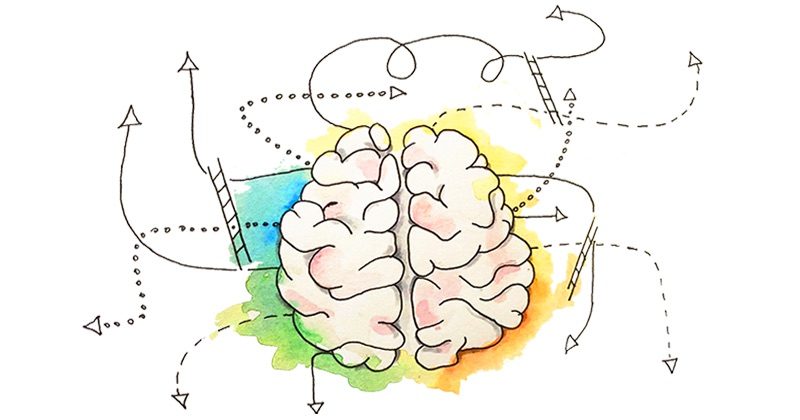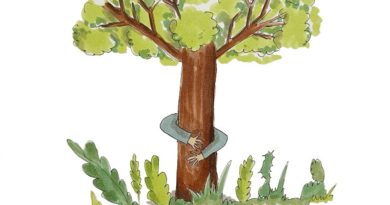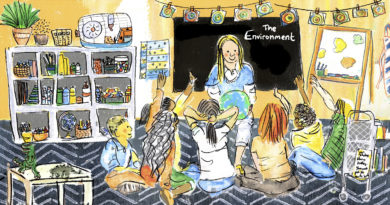The Importance of Being Flexible
When my family sits around the kitchen table and start talking – or playing, as we like to see it – it might seem to onlookers like pandemonium, or even that we might at times be angry with each other; nothing could be further from the truth. The verbal thread runs quickly when we talk, and it takes tortuous and, at times, torturous paths. We are honest and respectful, and we don’t allow phones. We love to discuss problems real and imaginary, global and personal, verbal and mathematical; it really doesn’t matter. We can interrupt, disagree – even vehemently – make puns, call each other out for a ridiculous statement or argument; and every topic, yes,every topic is allowed. We discuss day-to-day stuff, parallel universes, same sex marriage. We ask, “What might extreme right-wing groups be thinking?” “Is Bitcoin the future?” and “What would Boris Johnson look like if he were female?” Key elements in these discussions are a love of brainstorming, posing and solving problems in as many ways as possible, and finding or constructing connections between topics, often in new ways. Also important are our loving relationships – all mixed up with a good sense of humor. I guess you could say we all seem to have acquired a hearty dose of flexible thinking at some point in our lives.
It wasn’t until I began teaching at a university in the U.S. that I realized that not everyone can jump from topic to topic or consider many different perspectives of an issue or task, either verbally or visually. Continuing my science teaching duties at the ETH, I began to study didactics and pedagogy, and I met someone who felt, thought and acted as I did – an architect. Her family paralleled mine in many ways and in one way in particular – they were all flexible thinkers. We both took courses in gifted and talented education at the University of Connecticut as we pursued our Swiss education studies – for me as a university didactic expert and gymnasium teacher and for Christina as an educational coach for gifted children. Now I work as an educator, science editor and writer, and she works as a learning coach at various secondary schools and technical colleges. We got together this past week to talk about cognitive flexibility, its importance today, and how parents can help their kids develop this crucial ability. Below is a summary of our in-depth discussion framed as questions and answers.
Q. With the rapid pace of technological and social change underway, and the flood of information available to everyone at all times, children must learn to question, comprehend, weigh significance, adapt, and rethink their ideas continually: flexible thinking and the ability to adapt to unpredictable and novel information are thought to be crucial for these capabilities. But first, what is cognitive flexibility?
A. Generally speaking, cognitive flexibility is simply the ability to think about things in a different manner. It requires both flexible thinking and so-called set shifting. Flexible thinking is the ability to transition your thoughts among multiple concepts or perspectives either quickly or simultaneously. Set shifting is also important; you must “unlearn” a way of thinking or acting in order to “learn” or accept a new way.(1)
Q. How do you know if you or your child thinks flexibly?
A: I think it is easier to recognize rigid thinkers, the opposite of flexible thinkers. These individuals are set in their ways and dislike and avoid novel stimuli. They have difficulty adapting to change. They might want to sit in the same seat on the train each time they travel, or meet at the same restaurant; or they might believe that there is only one way to perform a task, e.g., to dress themselves in the same sequence every day. They also tend to take everything literally. A good example of a rigid-thinking character in a children’s book is Amelia Bedelia. Who could forget how the lovable housekeeper snips sponges and adds them to cake batter to make a sponge cake! Of course, her behavior is quite exaggerated. But young children can get an idea from these books.
Q: But aren’t young people today flexible thinkers? After all, they are “digital natives”?
A: Not necessarily. Just because you are adept at social media and can type fast on a smartphone doesn’t mean you are a flexible thinker. The young generation was introduced to these tools early on; they aren’t necessarily open to new stimuli. For instance, you might always google the same topic or the same worldview or play the same song on Spotify. If you use various search machines, the library catalogue, friends’ recommendations and books at home to search, then you are more flexible.
Q: Some researchers would say that the algorithms used in social media and streaming platforms encourage single-mindedness, because they analyze your behavior and then guide you, through prompting, further and further into a well-defined “thought/behavior” box so to speak. What can parents do to avoid this rabbit hole?
A: Youths and teens benefit greatly from open discussion about topics. Parents are role models for their children, as are teachers and other close adults. We can all model flexible thinking. Even if you have firm beliefs about something,you can try to discuss other ideas and possible views. I think reading a variety of books helps. Read a book with your child and talk about the different characters. Many studies show that language skills can enhance flexible thinking.
Thinking critically helps too! Often young children are notoriously inflexible, as are teachers and experts. Children like and need some routine; this generates security(2), but too much curtails and stifles cognitive flexibility. There are many easy ways to help children not only to cope with changes but also to think flexibly. For instance, Halloween is approaching. Suggest a new Halloween game for young children: “Let’s make our living room into a haunted house with words”: Spiders, ghosts, creepy-crawlies, blood, mummies, vampires, black cat, slime, spider webs, snakes, jars of brains and eyeballs, and bats might be some words your child supplies. If your child is too young to write, you can write out the words, or draw the items or cut out pictures. Next, place them haphazardly around the room. Then ask the child to group the items, by size (big versus little) or color (green, black, white, red) – an easy start. Then switch the clustering to the other exercise. For school-age kids, increase the difficulty of the clustering: e.g., all the words that start with S, G, and so on, or words with long vowel sounds. For older kids you can introduce more abstraction: living versus non-living; or living versus dead versus fantasy versus inanimate objects; or animals versus people or parts of people, and fantasy creatures, non-living things. The act of grouping and regrouping requires flexible thinking.
There are many board games parents can play that encourage flexible thinking. My favorite is SET. Although it was designed for ages eight and up, don’t believe it – I’ve seen five-year-olds who were able to play this game and improve at it quickly. It is also a good game for adults. There is an online version at setgame.com. Here are some more good games: Quiddler, Rummikub, Traffic, Zangle, and Tangrem or any puzzle with more than one solution.
Q: You mentioned coping with flexibility earlier, what did you mean by that?
A: Usually, that involves planning. Planning helps us cope with situations that are new; if we know what is going to happen, more or less, we can analyze it and we can plan for it. Planning for change is beneficial and learning to plan is a prerequisite for school success. However, being able to plan is not the same as having a high degree of flexible cognition.
Q: So how is cognitive flexibility different?
A: Flexible thinking has to do with how our brain’s wiring shifts in response to changing intellectual demands and novel situations. In a completely new situation, how do we use, or process, this information and use our brain connections to solve problems and deal with these situations. The adaptive reasoning and problem-solving abilities are quite a flexible form of intelligence. According to Barbey[1], “Rather than forming permanent connections in our brains, we are constantly updating our prior knowledge, and this involves forming new connections.” The more readily the brain forms and reforms its connectivity in response to changing needs, the better it works.
Q: I recently read Barbey’s exciting neuroscience work about flexibility – that it might be the basis for human intelligence – in a summary posted in Science Daily[2]. One quote struck me: “Emerging neuroscience evidence suggests that intelligence reflects the ability to flexibly transition between brain network states.” This is very abstract; can you give us some ways parents can help children to develop this ability?
A: The old idea that children are born into the world as empty vessels that parents and educators must fill with information through drilling and rote memorization, even using punishment, is no longer stressed. First, try to make all aspects of learning fun and enjoyable for your children, no matter their ages. Learning new information and new ways of thinking should not be stressful. Allow your children to make up stories. Or tell a story and ask them to give an ending, then think of another ending. Play games you know and change some rules of the game. Let the child change the rules. Older children can make up games and rules themselves. Play a rhyming game with words: seal, peal, deal, etc. Then switch to a different word game: think of words that rhyme and have a double “e” sound, e.g., deed, mead, lead, need, etc. Then switch back and forth between the two. If your child prefers solving math problems, then you can switch from solving addition to subtraction problems. You can switch from rhyming words to solving math problems too. Adjust the difficulty of the tasks to the ability of your child. Let your children help you with cooking. Follow a recipe but change some of the ingredients; substitute raisins for walnuts, or even try to eliminate ingredients to see what happens. We’ve all forgotten to include baking powder when baking a cake, haven’t we?
Really simple things can help: when you walk or drive to the store, travel a different route than usual. For a day’s outing: take a map of Switzerland, close your eyes, and toss a coin onto the map; then visit the area on the map where the coin landed. And going back to your introductory paragraph, talk with your children, about anything and everything. Ask them to give grounds for their thoughts; then think of another view of that topic that someone else might have. And never tell them their ideas don’t count. Add humor to your family life – jokes, puns, and comedy. Read Amelia Bedelia to your young children or allow them to read it. Read or re-read The Importance of Being Earnest by Oscar Wilde. And give it to your older child to read, too. Thank you, Christina for spending so much time with me. It has been a pleasure!
By Dr. Teresa Bingham Müller with Christina Merz
Teresa is an earth scientist and educator. She currently works as an educator, science writer and editor. She has three adult sons and two adorable grandchildren. Christina is an architect, building biologist and educator. She has two adult children and works as an educational coach.
Illustration by Aleksandra Koroleva
Aleksandra, originally from Moscow, Russia, now lives in Adliswil with her husband and 3.5-year-old son. She specializes in clinical psychology and started studying illustration after her son’s birth. In her free time Aleksandra likes sleeping, just as all mothers do. https://www.instagram.com/uber_evil
Footnotes
(1) For an example of set shifting, please see “Flexible Integration: Bending without Breaking.”
(2) For more information about planning for change, please see our Education column “Coping with Change at Home and School.”
References
[1] Aron K. Barbey. “Network Neuroscience Theory of Human Intelligence.”Trends in Cognitive Sciences, 2017 DOI: 10.1016/j.tics.2017.10.001
[2] Available under: https://www.sciencedaily.com/releases/2017/11/171120085456.htm




